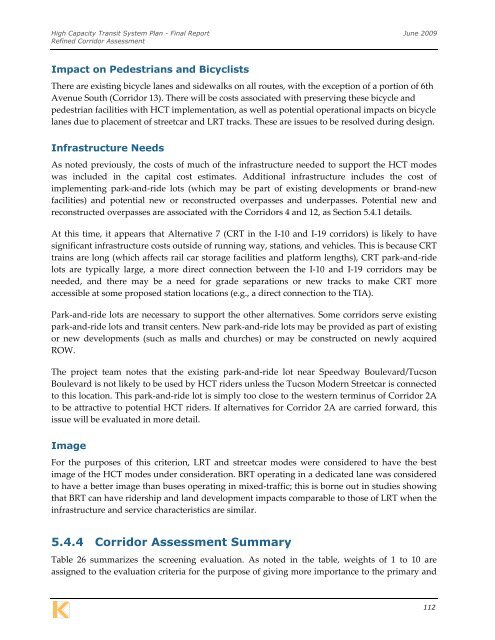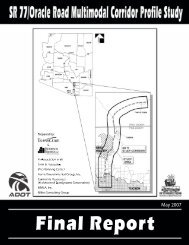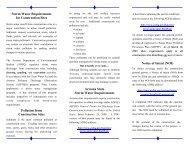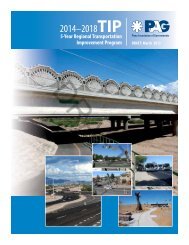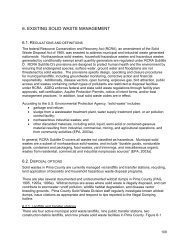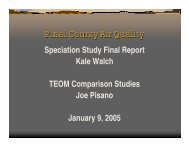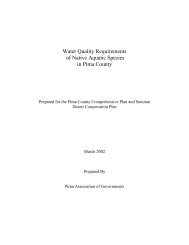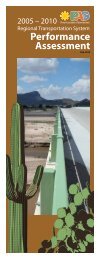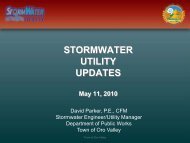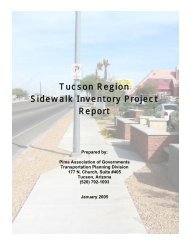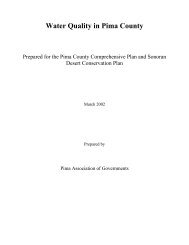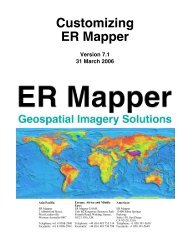Final Report - Pima Association of Governments
Final Report - Pima Association of Governments
Final Report - Pima Association of Governments
Create successful ePaper yourself
Turn your PDF publications into a flip-book with our unique Google optimized e-Paper software.
High Capacity Transit System Plan - <strong>Final</strong> <strong>Report</strong> June 2009<br />
Refined Corridor Assessment<br />
Impact on Pedestrians and Bicyclists<br />
There are existing bicycle lanes and sidewalks on all routes, with the exception <strong>of</strong> a portion <strong>of</strong> 6th<br />
Avenue South (Corridor 13). There will be costs associated with preserving these bicycle and<br />
pedestrian facilities with HCT implementation, as well as potential operational impacts on bicycle<br />
lanes due to placement <strong>of</strong> streetcar and LRT tracks. These are issues to be resolved during design.<br />
Infrastructure Needs<br />
As noted previously, the costs <strong>of</strong> much <strong>of</strong> the infrastructure needed to support the HCT modes<br />
was included in the capital cost estimates. Additional infrastructure includes the cost <strong>of</strong><br />
implementing park‐and‐ride lots (which may be part <strong>of</strong> existing developments or brand‐new<br />
facilities) and potential new or reconstructed overpasses and underpasses. Potential new and<br />
reconstructed overpasses are associated with the Corridors 4 and 12, as Section 5.4.1 details.<br />
At this time, it appears that Alternative 7 (CRT in the I‐10 and I‐19 corridors) is likely to have<br />
significant infrastructure costs outside <strong>of</strong> running way, stations, and vehicles. This is because CRT<br />
trains are long (which affects rail car storage facilities and platform lengths), CRT park‐and‐ride<br />
lots are typically large, a more direct connection between the I‐10 and I‐19 corridors may be<br />
needed, and there may be a need for grade separations or new tracks to make CRT more<br />
accessible at some proposed station locations (e.g., a direct connection to the TIA).<br />
Park‐and‐ride lots are necessary to support the other alternatives. Some corridors serve existing<br />
park‐and‐ride lots and transit centers. New park‐and‐ride lots may be provided as part <strong>of</strong> existing<br />
or new developments (such as malls and churches) or may be constructed on newly acquired<br />
ROW.<br />
The project team notes that the existing park‐and‐ride lot near Speedway Boulevard/Tucson<br />
Boulevard is not likely to be used by HCT riders unless the Tucson Modern Streetcar is connected<br />
to this location. This park‐and‐ride lot is simply too close to the western terminus <strong>of</strong> Corridor 2A<br />
to be attractive to potential HCT riders. If alternatives for Corridor 2A are carried forward, this<br />
issue will be evaluated in more detail.<br />
Image<br />
For the purposes <strong>of</strong> this criterion, LRT and streetcar modes were considered to have the best<br />
image <strong>of</strong> the HCT modes under consideration. BRT operating in a dedicated lane was considered<br />
to have a better image than buses operating in mixed‐traffic; this is borne out in studies showing<br />
that BRT can have ridership and land development impacts comparable to those <strong>of</strong> LRT when the<br />
infrastructure and service characteristics are similar.<br />
5.4.4 Corridor Assessment Summary<br />
Table 26 summarizes the screening evaluation. As noted in the table, weights <strong>of</strong> 1 to 10 are<br />
assigned to the evaluation criteria for the purpose <strong>of</strong> giving more importance to the primary and<br />
112


